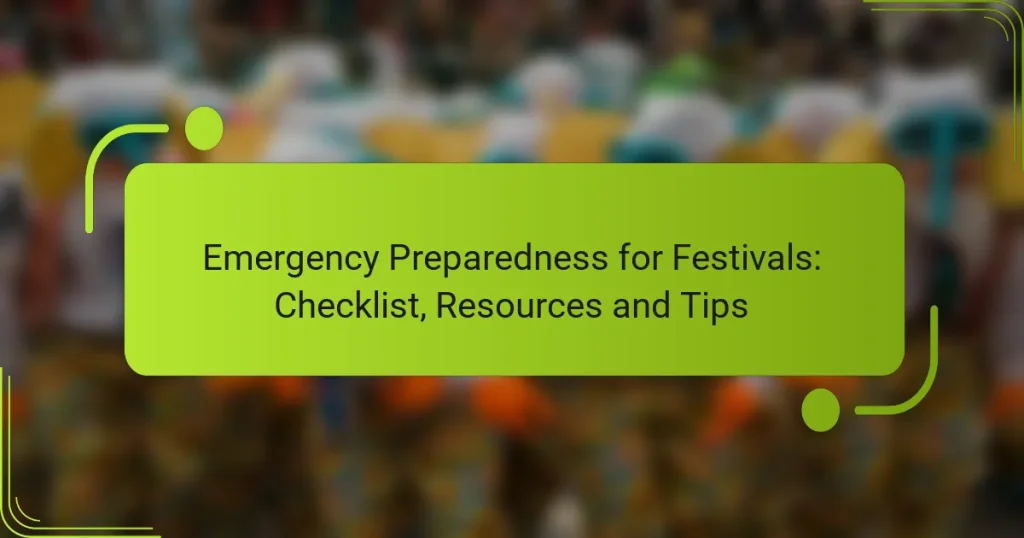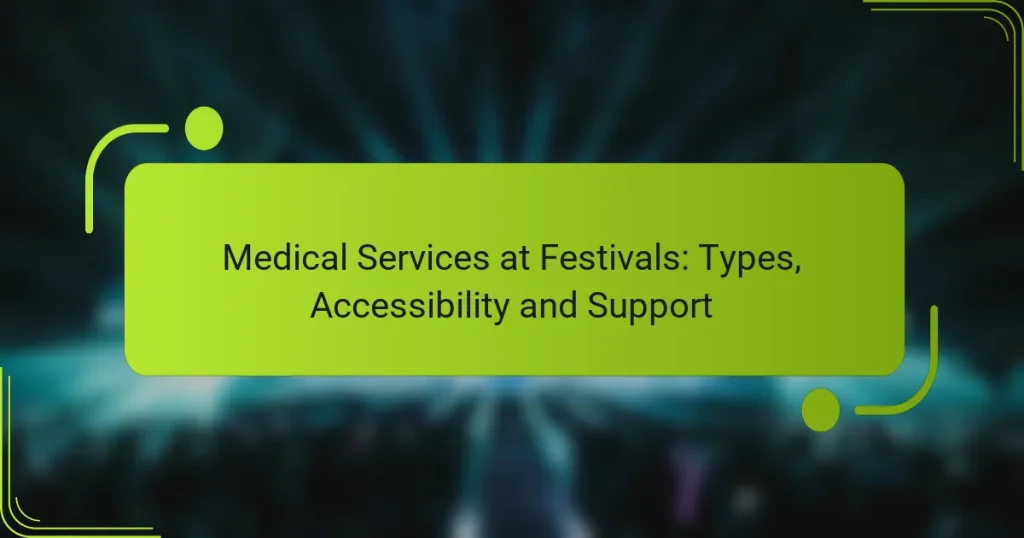Ensuring safety at festivals and clubs is crucial for creating a secure and enjoyable environment for attendees. By implementing comprehensive safety measures such as emergency response plans, trained security personnel, and effective access control, organizers can significantly mitigate potential risks. Additionally, leveraging technology for crowd management and communication further enhances safety, allowing for a more seamless experience for all participants.
Medical Services at Festivals: Types, Accessibility and Support
Alcohol Policies at Festivals: Regulations, Compliance and Guidelines
Handling Lost Items at Festivals and Clubs: Steps, Resources and Contacts
Security Personnel at Festivals: Roles, Responsibilities and Impact
Safety in Crowded Clubs: Essential Strategies and Precautions
How can festivals ensure safety for attendees?
Festivals can enhance safety for attendees by implementing comprehensive safety measures that address potential risks. This includes emergency response plans, trained security personnel, effective access control measures, health and safety protocols, and collaboration with local authorities.
Emergency response plans
Emergency response plans are crucial for managing unexpected incidents at festivals. These plans should outline procedures for various scenarios, such as medical emergencies, severe weather, or security threats. Regular drills and training sessions ensure that staff are prepared to act swiftly and effectively.
Key components of an emergency response plan include clear communication channels, designated roles for staff, and accessible first aid stations. It’s also beneficial to have a system for crowd management to prevent panic during emergencies.
Security personnel training
Training security personnel is essential for maintaining a safe environment at festivals. Security staff should be well-versed in conflict resolution, crowd control, and emergency procedures. Regular training updates help them stay informed about the latest safety protocols and potential threats.
In addition to basic training, specialized courses in areas such as first aid and crisis management can enhance the effectiveness of security teams. Engaging local law enforcement in training exercises can also improve coordination during events.
Access control measures
Implementing access control measures helps manage the flow of attendees and enhances overall safety. This can include ticketing systems, wristbands, and checkpoints to monitor entry and exit points. Effective access control reduces the risk of overcrowding and unauthorized access.
Using technology such as RFID wristbands can streamline entry processes and provide real-time data on attendee numbers. It’s important to ensure that staff are trained to handle access control efficiently to minimize wait times and maintain a positive experience.
Health and safety protocols
Health and safety protocols are vital for preventing accidents and ensuring the well-being of festival-goers. This includes measures such as providing adequate sanitation facilities, ensuring food safety, and having medical personnel on-site. Regular inspections can help identify and mitigate potential hazards.
Festivals should also consider implementing guidelines for alcohol consumption and drug use to promote a safer environment. Clear signage and information about health services available at the venue can further enhance attendee safety.
Collaboration with local authorities
Collaboration with local authorities is essential for effective safety management at festivals. Engaging with police, fire departments, and health services can provide valuable resources and support. This partnership helps ensure that safety measures align with local regulations and best practices.
Regular meetings with local authorities before the event can facilitate communication and coordination. Establishing a clear chain of command during the festival allows for quick responses to any incidents that may arise.
What safety measures should clubs implement?
Clubs should implement a range of safety measures to ensure the well-being of their patrons. Key strategies include staff training, surveillance systems, capacity management, and ensuring emergency exits are accessible.
Staff training programs
Effective staff training programs are crucial for maintaining safety in clubs. Employees should be trained in emergency response, conflict resolution, and crowd management to handle various situations that may arise.
Regular drills and refresher courses can help keep staff prepared. Consider incorporating scenario-based training to simulate real-life situations, enhancing their ability to react swiftly and effectively.
Surveillance systems
Surveillance systems play a vital role in monitoring club activities and ensuring safety. High-definition cameras should be strategically placed to cover entrances, exits, and key areas within the venue.
Integrating real-time monitoring with a dedicated security team can help identify potential issues before they escalate. Ensure that footage is stored securely and is easily accessible for review if needed.
Capacity management
Capacity management is essential for preventing overcrowding, which can lead to dangerous situations. Clubs should establish a maximum occupancy limit based on local regulations and the venue’s layout.
Implementing a ticketing system can help control the number of patrons entering the venue. Regularly reviewing attendance patterns can assist in adjusting capacity limits to maintain safety without compromising the experience.
Emergency exit accessibility
Ensuring emergency exit accessibility is critical for the safety of clubgoers. All exits should be clearly marked, unobstructed, and easily accessible at all times.
Conduct regular inspections to confirm that emergency exits are functional and that staff are aware of their locations. Consider installing illuminated exit signs and conducting drills to familiarize patrons with exit routes during emergencies.
What technology enhances safety at events?
Various technologies significantly enhance safety at festivals and clubs by improving crowd management, communication, and emergency response. These tools help organizers monitor attendees and ensure a secure environment.
Mobile safety apps
Mobile safety apps provide attendees with essential information and emergency contacts at their fingertips. Users can report incidents, receive real-time alerts, and access safety resources directly from their smartphones.
When choosing a mobile safety app, consider features like location tracking, emergency notifications, and user-friendly interfaces. Popular apps often include options for sharing safety tips and connecting with local authorities.
RFID wristbands
RFID wristbands enhance event safety by allowing for secure entry and tracking of attendees. These wristbands can be used to manage access to restricted areas and monitor crowd flow, helping to prevent overcrowding.
Incorporating RFID technology can streamline check-in processes and reduce wait times. Ensure that the wristbands are durable and waterproof to withstand various festival conditions.
Real-time communication tools
Real-time communication tools facilitate instant messaging among staff and security personnel, enabling quick responses to incidents. These tools can include walkie-talkies, dedicated apps, or group messaging platforms.
Effective communication is crucial during emergencies, so choose tools that offer reliable connectivity and user-friendly interfaces. Regular training on these tools can enhance staff readiness and coordination during events.
How do local regulations impact event safety?
Local regulations play a crucial role in ensuring safety at festivals and clubs by establishing guidelines that event organizers must follow. These regulations cover various aspects, including licensing, health standards, and fire safety, which collectively help mitigate risks and protect attendees.
Licensing requirements
Licensing requirements vary by location but generally include obtaining permits for the event, serving alcohol, and ensuring compliance with local noise ordinances. Event organizers should check with local authorities to understand the specific licenses needed, as failure to secure the appropriate permits can lead to fines or event cancellation.
In many jurisdictions, a special event permit is necessary, which may require submitting detailed plans about the event layout, expected attendance, and safety measures. It’s advisable to apply for these permits well in advance, as processing times can range from a few weeks to several months.
Health department guidelines
Health department guidelines focus on sanitation, food safety, and crowd health management. These guidelines often dictate the standards for food vendors, restroom facilities, and emergency medical services at the event. Compliance with these regulations is essential to prevent health hazards and ensure a safe environment for all attendees.
Organizers should work closely with local health officials to ensure that all food vendors are licensed and that proper hygiene practices are followed. Regular inspections may be required, and having a plan for managing potential health emergencies can further enhance safety.
Fire safety codes
Fire safety codes are critical for minimizing fire risks at festivals and clubs. These codes typically require the installation of fire extinguishers, clear exit paths, and adherence to occupancy limits. Event organizers must ensure that all structures, including tents and stages, meet local fire safety standards.
It’s beneficial to conduct a fire safety assessment before the event, which may involve consulting with local fire marshals. Additionally, training staff on emergency evacuation procedures and having a clear communication plan can significantly improve safety and preparedness in case of a fire emergency.
What role do attendees play in safety?
Attendees play a crucial role in ensuring safety at festivals and clubs by being vigilant and proactive. Their actions, such as reporting concerns and adhering to safety protocols, contribute significantly to a secure environment for everyone.
Reporting suspicious activity
Reporting suspicious activity is essential for maintaining safety at events. Attendees should be aware of their surroundings and trust their instincts; if something feels off, it’s important to notify security or event staff immediately.
Common signs of suspicious behavior include individuals loitering without purpose, unusual interactions, or anyone attempting to bypass security measures. By communicating these observations, attendees can help prevent potential incidents and ensure a safer atmosphere.
Following safety protocols
Following established safety protocols is vital for all attendees at festivals and clubs. This includes understanding emergency exits, adhering to capacity limits, and complying with any health guidelines in place.
Attendees should familiarize themselves with the venue’s safety measures, such as designated meeting points in case of evacuation. Additionally, wearing wristbands or identification provided by the event can facilitate quick identification and assistance during emergencies.





